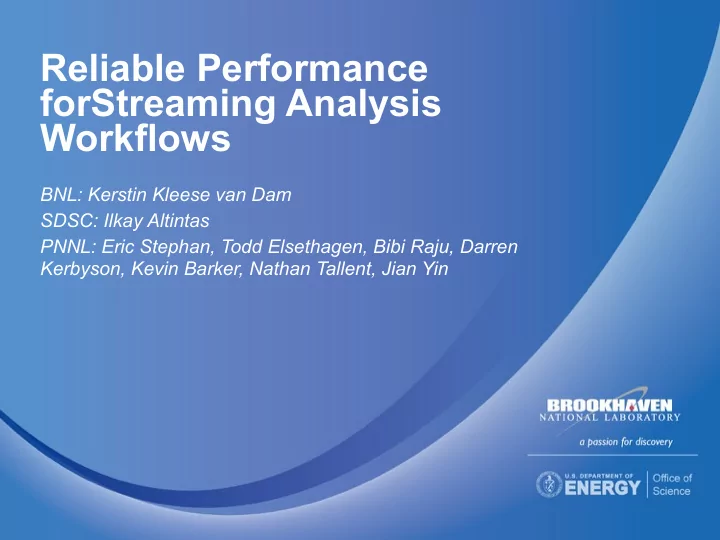

Reliable Performance forStreaming Analysis Workflows BNL: Kerstin Kleese van Dam SDSC: Ilkay Altintas PNNL: Eric Stephan, Todd Elsethagen, Bibi Raju, Darren Kerbyson, Kevin Barker, Nathan Tallent, Jian Yin
Use Case : In Operando catalysis experiments Data sets from different techniques: Integration of data for highest scientific impact X-ray Absorption Spectroscopy Global average structure and electronic structure Transmission Electron Microscopy Experimental measurements • Physical and electronic made with sample ‘in a working structure of individual catalysts condition’ • Different measurements needed to capture all aspect of system Infrared Spectroscopy Direct determination of • Multi—Modal, In-situ analysis surface adsorbates coupled with predictive modeling transformative Stach, Frenkel providing understanding and Nat. Comm. 2015 control of process
Complex Modeling • Use of multiple data and information improves reliability by defining limits of both calculated and experimental results • DiffPy-CMI, SumLib and SciKit-Beam in the CiffPy framework provide a streaming data integration and analysis framework for experimental and numerical simulation data. • Many application use cases see web site. Billinge, J. Appl. Cryst., 2014 www.diffpy.org
Challenges in in-situ experimental analysis • Goal - Provide enough targeted information to the scientists, early enough, to enable them to take critical decisions on steering of the data taking and its analysis • Critical characteristics : • Speed, Accuracy, Completeness (incl. background, prediction) • Information selection and representation • Different programing languages, programming models, heterogenous data, computing and networking infrastructure • Essential - Reliable in Time Result Delivery
DOE ASCR - Integrated End-to-End Performance Prediction and Diagnosis for Extreme Scientific Workflows Aim to provide an integrated approach to the modeling of extreme scale scientific workflows Brings together researchers working on modeling / simulation / empirical analysis, workflows and domain scientists Builds upon existing research much of which has focused to date on large- scale HPC systems and applications Explore in advance – Design-space exploration & Sensitivity Analyses Optimize at run-time – Guide execution based on dynamic behavior
Expanding Provenance: Empirical Information Gathering Today we only have hypothesis on what causes the variability in workflow performance or how performance could be improved IPPD will use provenance to capture empirical performance information from workflows and systems to: Collect quantitative performance information to investigate workflow performance variability, degradation, sensitivity and impact Provide empirical data backed assessments of particularly prevalent performance bottlenecks and sources of performance variability Provide a record of performance changes over time that can be correlated with changes to applications, workflows and systems
ProvEn Overview Provenance Environment (ProvEn) - A Provenance production and collection framework. Provides services and libraries to collect provenance produced in a distributed environment ProvEn Client API aids in the production of provenance from client applications The following types of provenance are collected: Time series-based information from a system/host perspective Performance metrics tracking from an application/ workflow perspective ProvEn enables building of accurate Machine Learning models by capturing detailed footprints of large-scale execution traces. ProvEn will support identification of sources of performance variability in streaming analysis workflows, and provide runtime guidance to Predictive resource allocation systems. Analytics
Provenance Environment (ProvEn) Architecture ProvEn Services Infrastructure Provenance capture through messaging services and web service APIs Server / provenance consumer (semantic information, triple store) Client API library / provenance producer Time-series client/server (in progress, InfluxDB)
Initial System Test and Validation Test System : SeaPearl at PNNL - 52 node cluster, instrumented with sensors that include temperature and power usage Test Application : Firestarter, a stress test tool that can create varying workloads with predictable amounts of heat generation by the CPUs Sampling Speed : Two nodes are monitored at 10KHz / 36M measurements / hour using a Lua script running on each node that pipes streaming measurements in parallel into the InfluxDB database. Correlation: To correlate performance measures in the time series database to the provenance store the Network Time Protocol (NTP) is relied upon as the time source.
Questions? Kerstin Kleese van Dam, kleese@bnl.gov
Recommend
More recommend